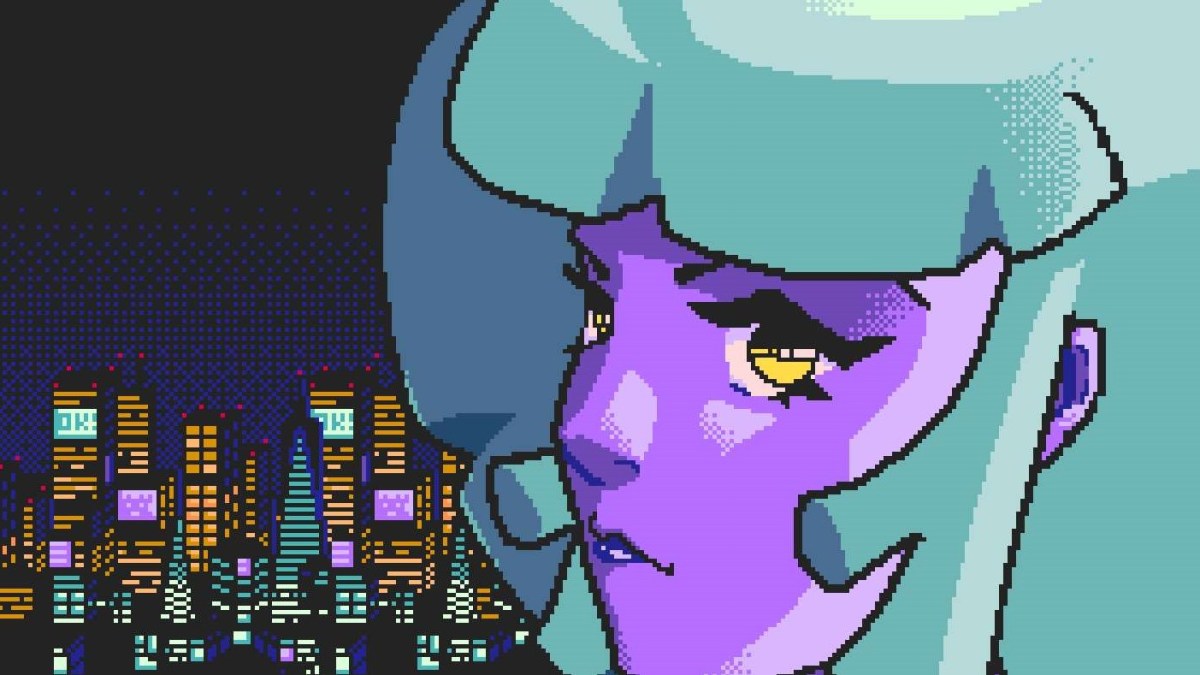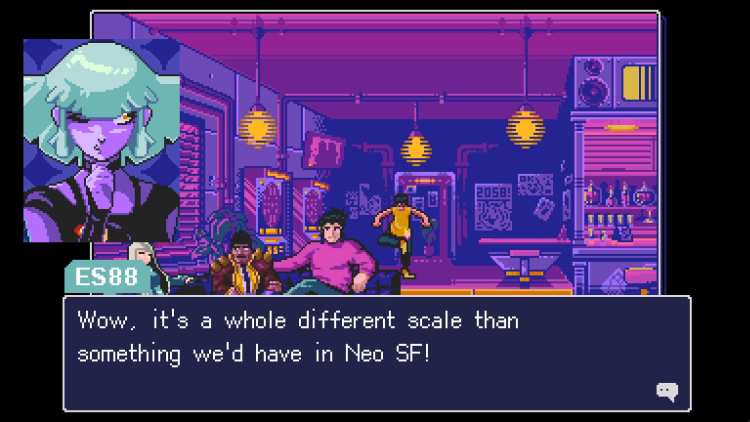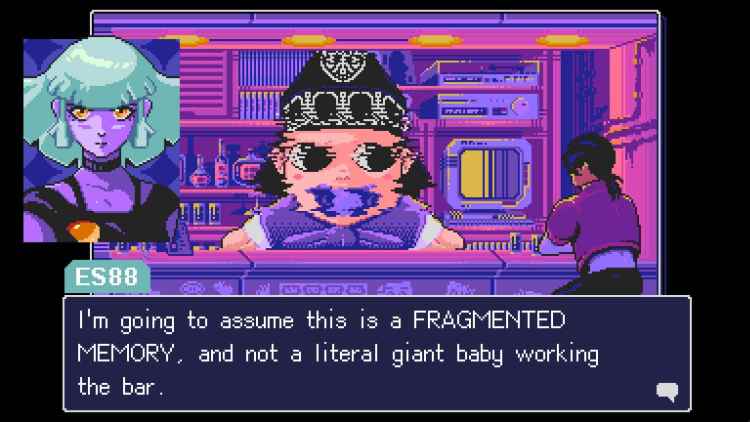Featuring a fantastical setting and character-driven story, Read Only Memories: Neurodiver blends together elements from old school point-and-click adventure games and a visual novel. In it, players enter the retrofuturistic sci-fi world of Neo San Francisco and take the role of ES88, a telepath who is training to become an Esper – a professional mind-melder who uncovers hidden memories and fixes broken ones. She does this by using a genetically engineered organism called a Neurodiver, which looks like a large sea creature, to facilitate a psychic link through direct skin contact.
That might sound like a lot to take in, but the short demo does a good job of explaining it all with a couple of paragraphs in the guise of cramming for Esper finals. It’s not long before the late-night studies are interrupted by ES88’s android friend GATE, who offers to let the aspiring Esper test her skills on a live client who needs his memories reconstructed.
That person, who is perfectly willing to have his head messed with by an unlicensed Esper, is named Crow and happens to be an ex-soldier and thief who is genetically modified to look like a humanoid feline. Then things start to get a little weird.
Diving straight into Read Only Memories: Neurodiver
Similar to 2064: Read Only Memories, the previous game in the franchise, Neurodiver is heavily inspired by point-and-click games from the 1980s and ’90s. Everything, including the 16-bit color pallet, 2D anime-style artwork, and hunting for interactive hotspots, is faithfully reminiscent of classic adventure games. Neurodiver, however, has a decidedly different feel from its predecessor. You now have a portrait of the main character and everyone she’s talking to, which change and animate with the dialogue.
The result is a game that often feels like an interactive comic book. This works extremely well with the unique story, characters, and artwork in bringing you into this world. But this early build also has a few obvious quirks. The first is that choices are a little thin in Read Only Memories: Neurodiver. Even though you are presented with multiple dialogue choices, there aren’t multiple solutions to challenges. Most dialogue choices end up circling you back onto a pre-determined path, but there are a few that add some personalization to the story.
For example, GATE asks you what motivates you to become an Esper. You can respond by saying you want to help people, to help find justice, or to preserve history. Depending on your choice, you’ll be introduced to Crow as a psychic therapist, investigator, or historian. It’s a cute little touch that helped to keep me engaged with the demo, but I can’t say for certain that it would motivate multiple playthroughs.
Lack of freedom
The other issue with the demo is that there isn’t a whole lot of freedom to experiment. At one point, ES88 warns Crow that poking through his memories could lead to irreparable psychic damage. However, any sense of danger gets thrown out once you figure out that there’s nothing you can do to cause harm.
Aside from the plot items, the only clickable objects are ones that provide a bit of trivial background information. One example is a poster that celebrates 2058 as the Year of the Tiger in the Chinese New Year. However, you can’t question characters and get to know them beyond a superficial level, which is strange for a character-driven game. It’s too bad, since I would have liked to learn a little more about the war, how Espers were discovered, and how GATE went from being a terminator to a friendly neighbor at a psychic academy. These topics are lightly touched on during the dialogue sequences, but players aren’t given an opportunity to explore them.
An open mind
Crow wants ES88 to probe his memories and find out what happened 10 years ago. He lost all the money from a major score, an incident that understandably drove a wedge between him and his friends. Apparently, he has scant recollections of what happened, which presents the perfect opportunity for a hands-on Neurodiving lesson.
It turns out, mind-melding isn’t difficult to figure out. It mainly involves replaying a memory while keeping an eye and mouse pointer out for vital clues. There’s some room for making independent dialogue decisions and actions. But not much, as all paths end up back on the same narrative road. They include dropping various one-liners and deciding whether or not to let someone win a game of futuristic footbag. Disappointingly, there are no mini-games or cutscenes in the demo, so things like kicking around a toy are only explained in written dialogue.
Another oversight in this early build of Read Only Memories: Neurodiver is that the interface and its instructions are a tad incomplete. For example, the demo informs you the pressing “I” opens your inventory. From there, you’re able to click and examine the different items. What’s missing is an X button to close inventory or the examine screen. Nor does the use of the convenient ESC button, which led to some random clicking and button-mashing before I remembered that I just had to press “I” again. It’s admittedly a small oversight, but they tend to build up, especially when the demo is only about 15 minutes long.
The other thing about being a Neurodiver is that it seems to be, judging by the demo, a pretty easy job. At least it is at this early part of the game. Broken memories stand out as random bits of subconscious imagery stuffed in as placeholders. For some reason, Crow couldn’t remember what the bartender looked like, so his mind replaced him with a giant baby. To fix the memory, I had to pull the only item I had in my inventory and match it to the memory, which was a little tricky since I wasn’t given any instruction on how exactly to do it. I spent about half a minute frantically trying to drop a drink poster onto the baby’s face before I noticed the little box next to it, which also happened to match will with the TV screen behind it. As I said, the little annoyances and oversights tend to build up, especially with puzzles this straightforward.
Fortunately, after learning this, I was well prepared to solve the next memory puzzle, which introduces the big mystery that will presumably drive the rest of the game.
A glimpse at what’s to come
The Read Only Memories: Neurodiver demo may be short and easy, but it does an excellent job of giving players a small taste of this strange world and its diverse cast of characters. I very much enjoyed playing the demo despite its gameplay quirks and love the artwork. Besides, there’s plenty of time for developer MidBoss to address my issues before the game officially releases later this year. The Read Only Memories: Neurodiver demo will be available at a later date, but you can add it to your wishlist for now.












Published: Mar 3, 2021 10:00 am